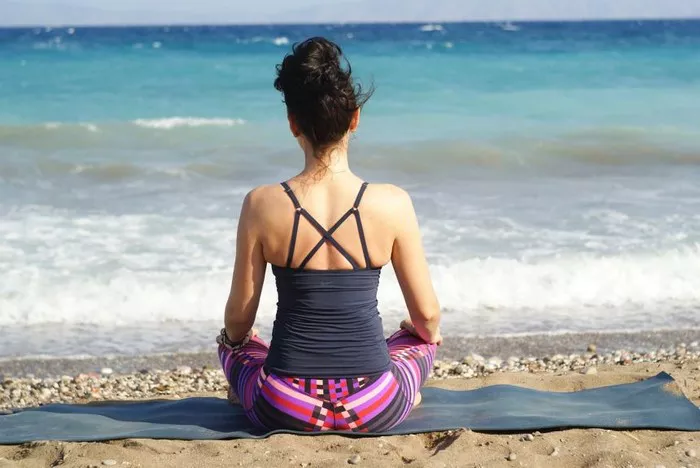In today’s modern world, with most of us leading sedentary lifestyles, it’s not uncommon to experience discomfort or pain in the spine. Sitting for long periods, improper posture, and lack of movement can all contribute to spinal compression, which can lead to pain, tension, and even injury. However, there’s good news: yoga, a practice with ancient roots, can offer a variety of effective postures to help decompress the spine, restore balance, and bring relief to those dealing with spinal issues.
Decompression of the spine is essential for overall health. When the spine is compressed, it puts pressure on the discs and nerves, potentially leading to discomfort, limited mobility, and a variety of other health concerns. Decompression helps by gently stretching the spine, allowing the discs to regain their optimal position and reducing pressure on the nerves. Many yoga poses are designed to stretch, lengthen, and open the spine, offering a natural solution to alleviate the discomfort of compression.
In this article, we will explore the top yoga poses that help decompress the spine, how they work, and the benefits they offer. Whether you’re a beginner or an experienced practitioner, these poses can be incorporated into your routine to help relieve tension and support spinal health.
Understanding Spinal Decompression
Before diving into the specific yoga poses, it’s important to understand what spinal decompression is and why it’s beneficial.
The spine is made up of vertebrae, discs, muscles, ligaments, and nerves. The vertebrae are the bones that form the structure of the spine, and between them are the intervertebral discs that act as cushions, absorbing shock and preventing friction. These discs, however, can become compressed due to poor posture, age, or repetitive movements, leading to pain and limited mobility.
Spinal decompression is the act of relieving pressure from the discs by creating space between the vertebrae. This can help reduce the strain on the nerves, ease discomfort, and improve flexibility. In yoga, we achieve spinal decompression through movements that promote spinal elongation, stretches, and gentle twists, all of which help restore balance and flexibility to the spine.
Now, let’s look at specific yoga poses that help achieve spinal decompression.
1. Child’s Pose (Balasana)
Child’s Pose is a restorative posture that gently stretches the spine and promotes relaxation. By kneeling and folding the body forward, this pose allows the spine to lengthen, creating space between the vertebrae and helping to relieve pressure.
How to Perform Child’s Pose:
- Start by kneeling on the floor with your knees slightly apart and your big toes touching each other.
- Slowly lower your hips back toward your heels and fold your torso forward.
- Rest your forehead on the mat and extend your arms out in front of you or place them alongside your body.
- Breathe deeply and hold the pose for 30 seconds to a minute.
Benefits:
- Gently decompresses the spine
- Relieves tension in the back, shoulders, and neck
- Encourages deep breathing and relaxation
- Promotes a sense of calm and stress relief
2. Cat-Cow Pose (Marjaryasana-Bitilasana)
Cat-Cow Pose is a dynamic spinal movement that alternates between arching and rounding the back. This fluid motion helps stretch and strengthen the spine while simultaneously decompressing the discs and improving flexibility.
How to Perform Cat-Cow Pose:
- Begin on your hands and knees in a tabletop position, with your wrists directly under your shoulders and your knees under your hips.
- On an inhale, arch your back, drop your belly toward the floor, and lift your chest and tailbone toward the ceiling (Cow Pose).
- On an exhale, round your back, tuck your chin toward your chest, and draw your navel toward your spine (Cat Pose).
- Repeat the flow for 5 to 10 rounds, moving with your breath.
Benefits:
- Improves spinal flexibility and mobility
- Stretches and strengthens the back and abdominal muscles
- Helps with spinal decompression by gently elongating the vertebrae
- Increases circulation to the spine
3. Downward-Facing Dog (Adho Mukha Svanasana)
Downward-Facing Dog is a classic yoga pose that helps stretch the entire back, from the neck to the tailbone. By creating an inverted V-shape with the body, this pose elongates the spine and decompresses the vertebrae.
How to Perform Downward-Facing Dog:
- Start in a tabletop position, with your hands under your shoulders and your knees under your hips.
- Lift your hips toward the ceiling, straightening your legs and pushing your heels toward the floor.
- Keep your arms extended, with your fingers spread wide, and your head between your arms, facing your knees.
- Hold the pose for 30 seconds to a minute, focusing on deep, steady breathing.
Benefits:
- Stretches and decompresses the spine
- Lengthens the hamstrings, calves, and back
- Strengthens the arms and core muscles
- Improves overall posture and alignment
4. Cobra Pose (Bhujangasana)
Cobra Pose is a backbend that helps open the chest and stretch the front of the body while decompressing the spine. This pose works by gently arching the back and lifting the chest, which creates space between the vertebrae.
How to Perform Cobra Pose:
- Begin lying face down on the mat, with your legs extended behind you and your palms placed on the floor under your shoulders.
- Press into your palms as you lift your chest off the ground, using your back muscles to guide the lift rather than relying solely on your arms.
- Keep your elbows slightly bent and avoid overextending your lower back.
- Hold the pose for 20 to 30 seconds, then lower your chest back to the ground.
Benefits:
- Gently stretches the spine and promotes decompression
- Opens the chest and shoulders
- Relieves tension in the lower back
- Strengthens the muscles of the back and arms
5. Seated Forward Fold (Paschimottanasana)
Seated Forward Fold is a deep stretch for the back, hamstrings, and calves that helps decompress the spine by folding the body forward and encouraging lengthening along the entire back.
How to Perform Seated Forward Fold:
- Sit on the floor with your legs extended straight out in front of you.
- Inhale and lengthen your spine, reaching your arms overhead.
- As you exhale, hinge forward at your hips and reach for your feet or ankles.
- Keep your spine long, and avoid rounding your back excessively.
- Hold the pose for 30 seconds to a minute.
Benefits:
- Stretches the spine, hamstrings, and calves
- Relieves tension in the lower back
- Promotes spinal decompression by elongating the vertebrae
- Improves flexibility in the back and legs
6. Bridge Pose (Setu Bandhasana)
Bridge Pose is a backbend that helps stretch the spine and open the chest. By lifting the hips toward the ceiling and creating space between the vertebrae, this pose aids in spinal decompression and improves spinal alignment.
How to Perform Bridge Pose:
- Lie on your back with your knees bent and your feet flat on the floor, hip-width apart.
- Place your arms alongside your body, with your palms facing down.
- Press your feet into the floor and lift your hips toward the ceiling, squeezing your glutes and engaging your core.
- Hold the pose for 20 to 30 seconds, then lower your hips back to the floor.
Benefits:
- Stretches and decompresses the spine
- Strengthens the glutes, legs, and lower back muscles
- Opens the chest and shoulders
- Improves posture and alignment
7. Happy Baby Pose (Ananda Balasana)
Happy Baby Pose is a gentle stretch that targets the lower back and hips. By bringing the knees toward the chest and gently pulling them outward, this pose decompresses the spine and relieves tension in the lower back.
How to Perform Happy Baby Pose:
- Lie on your back and draw your knees toward your chest.
- Grab the outer edges of your feet with your hands, keeping your knees bent and your feet flexed.
- Gently pull your knees down toward the floor, keeping your back flat on the mat.
- Hold the pose for 30 seconds to a minute, breathing deeply.
Benefits:
- Gently decompresses the spine
- Opens the hips and relieves tension in the lower back
- Improves flexibility in the hips and thighs
- Promotes relaxation and stress relief
8. Spinal Twist (Supta Matsyendrasana)
A gentle spinal twist is an effective way to decompress the spine and increase flexibility. The twisting motion helps to create space between the vertebrae and allows for a deeper stretch in the back muscles.
How to Perform Spinal Twist:
- Lie on your back with your arms extended out to the sides in a T-shape.
- Bring your knees toward your chest and gently lower them to one side while keeping your shoulders grounded on the floor.
- Turn your head to the opposite side of your knees.
- Hold for 30 seconds to a minute, then repeat on the other side.
Benefits:
- Gently decompresses the spine
- Improves spinal mobility and flexibility
- Relieves tension in the lower back and hips
- Promotes relaxation
Conclusion
Spinal decompression is a critical aspect of maintaining spinal health and overall well-being. Whether you’re dealing with back pain, stiffness, or simply want to improve your posture, yoga offers a variety of poses that can help decompress the spine. From restorative poses like Child’s Pose to more dynamic stretches like Cat-Cow, each posture offers unique benefits that contribute to the health and flexibility of the spine. By incorporating these poses into your regular practice, you can promote spinal health, reduce discomfort, and enhance your overall quality of life.
Related Topics:


















